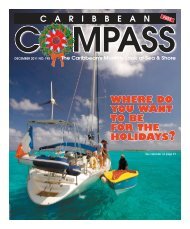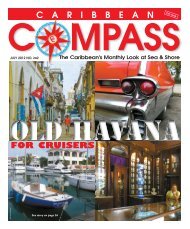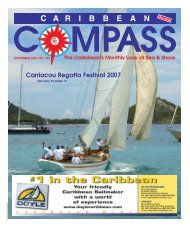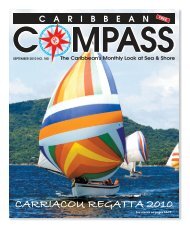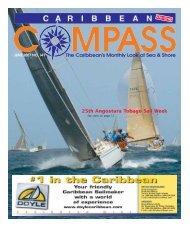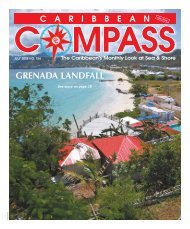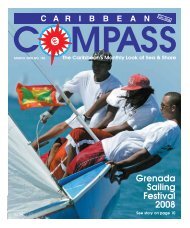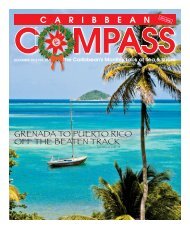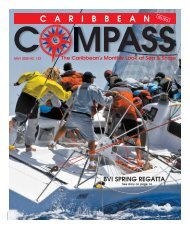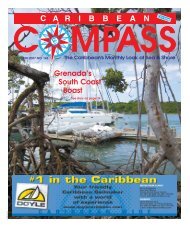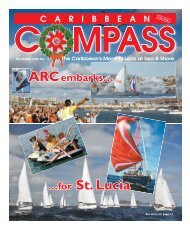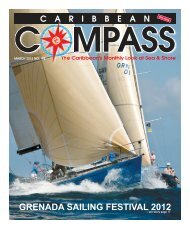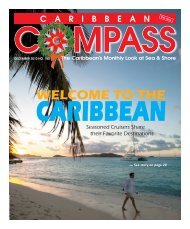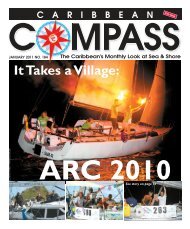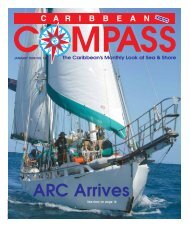Bequia Easter Regatta 2008 - Caribbean Compass
Bequia Easter Regatta 2008 - Caribbean Compass
Bequia Easter Regatta 2008 - Caribbean Compass
You also want an ePaper? Increase the reach of your titles
YUMPU automatically turns print PDFs into web optimized ePapers that Google loves.
APRIL <strong>2008</strong> CARIBBEAN COMPASS PAGE 22<br />
— Continued from previous page<br />
We travelled cautiously and to our delight the river widened and deepened, allowing<br />
us to increase our speed. As we got farther upstream, the vegetation on each side<br />
of the river was dense and forbidding but lush and green, with occasional mauveflowered<br />
trees and water cacao.<br />
Most families along the river live in open buildings and sleep in hammocks<br />
As we rounded a bend, we could see construction on both sides of the river. We<br />
later learned the Venezuelan government was building a school and hospital here.<br />
On our port side was a large blue, rectangular, metal-clad building. Behind that was<br />
a rustic but clean and well-organized set of buildings — clearly the Boca de Tigre<br />
Lodge. To starboard was a fairly large village. We pulled up just beyond the lodge<br />
and anchored with Sea Schell (another Tayana 42), just beyond Alouette. Before long<br />
we were unexpectedly joined by a third Tayana, Sea Gypsy. We were more than<br />
amazed that there were now three Tayana 42s in this remote location.<br />
We were welcomed ashore by an English-speaking family who told us they had<br />
moved to the area about 17 years ago as refugees from Guyana. This friendly family<br />
immediately began sharing gifts from their garden and small orchard where they<br />
were growing mangoes, lemons, coconuts and bananas. We shared our gifts of fabric,<br />
needles, thread, flour, cooking oil and children’s coloring and story books. We<br />
carried home some fruit and the assurance the family would take our two empty fuel<br />
cans with them on their fuel run to Tucupito in the morning.<br />
The family consisted of four adults and eight children. Their home was a typical<br />
stilt structure but with the addition of walls of clapboard. It also had beds. This was<br />
quite different from the homes of their neighbours, who lived in open frame buildings<br />
and slept in hammocks.<br />
Nearby was another open rectangular building that turned out to be a Christian<br />
church. They had been holding services for the past seven years. We later attended<br />
one of their Sunday services and were quite impressed that they could conduct it<br />
in three languages — English, Warao and Spanish — benefiting the small but<br />
mixed congregation.<br />
Our short visit at the Boca de Tigre Lodge showed it to be an immaculately maintained<br />
wilderness lodge, ready for customers, although we heard of only one being<br />
present at the time. The buildings consisted of single-storey structures, divided into<br />
private cubicles each with a double bed, table, toilet and wash sink. The grounds<br />
were groomed with the construction blending into the surrounding forest.<br />
—Continued on next page



